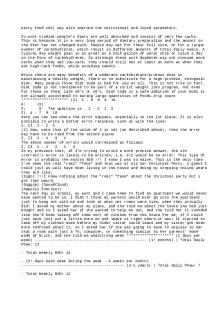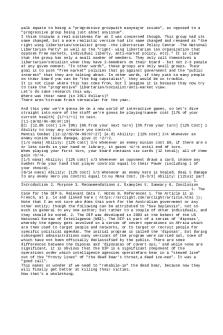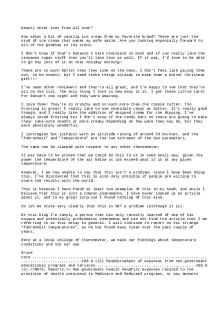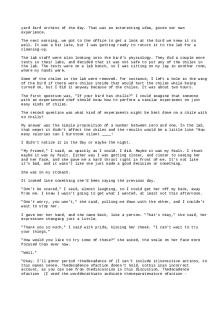Dichrometry analysis first semester analysis PDF

| Title | Dichrometry analysis first semester analysis |
|---|---|
| Author | Aiswarya Anil |
| Course | Pharmacy |
| Institution | Kerala University of Health Sciences |
| Pages | 2 |
| File Size | 52.5 KB |
| File Type | |
| Total Downloads | 15 |
| Total Views | 185 |
Summary
Simple notes of dichrometry first semester analysis...
Description
DICHROMETRY Titration involving potassium dichromate as the oxidizing agent is called dichrometry. The method is based on the oxidation of dichromate ion. The oxidizing action is due to the conversion of dichromate ion containing sexivalent chromium to Cr3+ Cr2O72- + 14H+ + 6e-
2Cr3+ + 7H2O
Since this conversion requires H+ ions, the reaction take place in acidic medium. Advantages of potassium dichromate over potassium permanganate 1. Easy to prepare the chemically pure substance where as potassium permanganate is not chemically pure due to the presence of MnO2 and other reduce products, so exact weighing is not possible. But dichromate solution can be prepared by exact weighing. 2. Potassium permanganate is not a stable solution. It decomposes in the presence of light, acid etc, whereas potassium dichromate when kept in closed vessel is highly stable. It doesnot decompose even when the acidified solution is boiled 3. Potassium dichromate is used as primary standard because it is available in the pure form, thermally stable, has definite shelf life and is less expensive. A disadvantage of potassium dichromate as an oxidizing agent is that the titration give rise to Cr3+ ions which imparts green colour to the solution, so it is difficult to detect the end point. The usual indicators used are N-phenyl anthranilic acid, diphenylamine sulfonate, sodium or barium salt of diphenyl amine sulphonic acid is more suitable because it is more soluble than diphenyl amine in water and gives a sharp colour change from colourless-green- red violet. Applications 1. Determination of iron in iron ore Ore is dissolved in hydrochloric acid where iron (III) is reduced to iron (II) and the solution is titrated with standard dichromate solution. Cr2O72+ + 6Fe2+ + 14H+
2Cr3+ + 6Fe3+ + 7H2O
2. Determination of chromium in chromium (III) salt 3. Chemical oxygen demand can be determined by dichrometry Preparation of potassium dichromate (0.0167M) Weigh 4.9 g of potassium dichromate, previously powdered and dried in a desiccator for 4 hours, and dissolve in sufficient water to produce 1000 ml.
Standardisation of 0.0167 M potassium dichromate To 20.0 ml of the solution add 1 g of potassium iodide and 7 ml of 2M hydrochloric acid. Add 250 ml of water and titrate with 0.1 M sodium thiosulphate, using 3 ml of starch solution, added towards the end point of the titration, as indicator until the colour changes from blue to light green. 1ml of 0.1 M sodium thiosulphate is equivalent to 0.0049 g of K2Cr2O7 References 1. Pharmaceutical Analysis-I by Dr Uttam Singh Baghel, Dr Pragi Arora, page no: 79 2. IP Volume 1 2010, page no: 633 3. Basics of Drug Analysis by G Vidya Sagar, page no: 213-214...
Similar Free PDFs

Art First exam photo analysis
- 3 Pages

First semester calculus notes
- 143 Pages

(first semester-2021)
- 12 Pages

Physiology 2130A First Semester
- 36 Pages
Popular Institutions
- Tinajero National High School - Annex
- Politeknik Caltex Riau
- Yokohama City University
- SGT University
- University of Al-Qadisiyah
- Divine Word College of Vigan
- Techniek College Rotterdam
- Universidade de Santiago
- Universiti Teknologi MARA Cawangan Johor Kampus Pasir Gudang
- Poltekkes Kemenkes Yogyakarta
- Baguio City National High School
- Colegio san marcos
- preparatoria uno
- Centro de Bachillerato Tecnológico Industrial y de Servicios No. 107
- Dalian Maritime University
- Quang Trung Secondary School
- Colegio Tecnológico en Informática
- Corporación Regional de Educación Superior
- Grupo CEDVA
- Dar Al Uloom University
- Centro de Estudios Preuniversitarios de la Universidad Nacional de Ingeniería
- 上智大学
- Aakash International School, Nuna Majara
- San Felipe Neri Catholic School
- Kang Chiao International School - New Taipei City
- Misamis Occidental National High School
- Institución Educativa Escuela Normal Juan Ladrilleros
- Kolehiyo ng Pantukan
- Batanes State College
- Instituto Continental
- Sekolah Menengah Kejuruan Kesehatan Kaltara (Tarakan)
- Colegio de La Inmaculada Concepcion - Cebu











